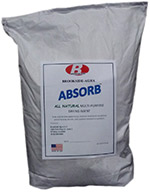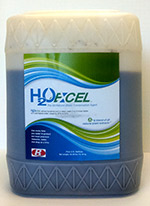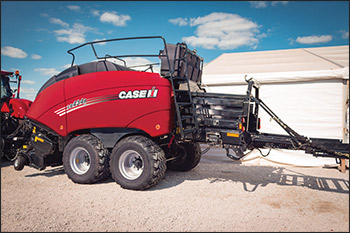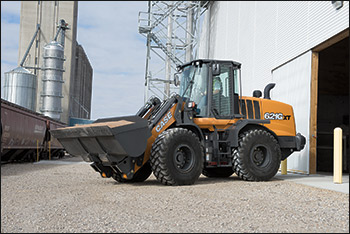New Products
Drying agent

Brookside Agra Absorb™
Brookside Agra is now offering Absorb™ — an all-natural, multi-purpose drying agent made in the USA.
With all ingredients classified as Generally Regarded As Safe (GRAS), the product provides superior, safe moisture absorption and odor control for a variety of purposes, including:
- Drying and reducing chill in all animal species including newborn piglets, swine, cattle, poultry, sheep, goats, horses and pets;
- Removing moisture and ammonia odor from livestock and recreational animal housing, poultry barns and kennels;
- Absorbing wetness in any area where moisture is a problem, such as food-processing facilities and commercial kitchens;
- Drying wet surfaces and flooring to reduce the chance of animal or human injury.
The company says the all-natural product reduces the risk of injury around the farm, in commercial kitchens and other areas where moisture can pose a slipping hazard.
Absorb can be sprinkled on animal bedding or flooring to absorb moisture and odors caused by urination, diarrhea or water. For newborn animals, it is recommended that the product be rubbed vigorously between its neck and tail until the animal is dry.
Absorb is available in a 40-pound (lb.) bag and can be purchased online in the United States at www.brookside-agra.com/products/animal-health/absorb/.
For more information and special ordering, contact Tim Nelson, vice president, animal health & nutrition sales, at 402-560-7381 or tim.nelson@brookside-agra.com.
Antibiotics website
Antibiotics are critical tools for treatment and control of diseases in livestock. Antibiotic resistance threatens the use of antibiotics in livestock for two important reasons. If resistance develops, the antibiotic may not be effective in treating the disease. Increased antibiotic resistance could lead to policies limiting access to antibiotics for use in livestock.
KSUantibiotics.org was created as a launching point to find information about antibiotics. The new site includes a section on antibiotic resistance, featuring new Kansas State University (K-State) fact sheets about how antibiotic resistance occurs and why livestock producers should care about antibiotic resistance.
Supported by a grant from the USDA National Institute of Food and Agriculture (NIFA), the website was developed by the K-State Department of Animal Sciences & Industry.
The website also includes links to sites that provide an overview of antibiotic resistance, mechanisms, the current knowledge about resistance in livestock production, the USDA and FDA action plans concerning resistance, and news feeds where you can find the latest information on the topic. Each of the subpages contains the major agency (e.g., WHO, FAO, CDC), producer group (National Pork Board), and journal publications on the topics.
Besides information on resistance, there are links to the rules concerning Veterinary Feed Directives (VFD) and other antibiotic regulations. Links to videos created by the Beef Cattle Institute can be found under the VFD section. Another section leads the user to reviews on the main alternatives to antibiotics that have been tested. The last section provides links to information on management practices that can reduce the need for antibiotics.
Producers are encouraged to visit KSUantibiotics.org to learn about antibiotic resistance and alternatives to antibiotics.
Quick biomass digestion

Brookside Agra H20 Excel
Brookside Agra’s agronomy operations is answering questions being asked by growers these days about processes that can be utilized to get more out of their soil and biomass after harvest is complete. The company says using biologicals along with components that support their growth, such as all-natural H2OExcel™, will break down biomass quickly and effectively, releasing stored nutrients back into the soil for spring planting.
In digester-type programs the company says it has seen improved breakdown of biomass when using a biological. Using a biological alone, however, can make the process slow and of little effect. Because biologicals function according to environmental factors like temperature and moisture, if you apply a biological alone, it may only have species that respond to those environmental factors present when they are applied.
The key to a successful digester program, the company says, is getting as many biologicals in the sprayer as possible and giving them the food they need to multiply rapidly.
When using a system that contains a biological combined with the components that support them, you should see a fairly quick response, according to the release.
H2OExcel is comprised of five primary modes of action to do this all naturally, according to the release. These are: 1. water management; 2. capillarity pressure change; 3. biological growth and activity; 4. saponins; and 5. humates for soil conditioning. The goal is to break down the biomass to make it easier to handle the following spring and to return as much of the stored nutrients to the soil in the forms that are stable and can be utilized for the next crop. This is an operation that will also support cover crops.
When utilizing a digester program, the first sign you should see is a color change that indicates the biologicals are reproducing and beginning to find their way into the biomass. In crops like corn, you will notice this color change and as rain begins to fall, the stalks will become more brittle.
The company recommends not to conduct any tillage operations in the fall in order to maintain the integrity of the biological ecosystems being constructed during this process.
Practices like a digestion program postharvest and using biological products are great ways to actively start adapting soil health methods and work toward a better understanding of your soil, inputs and yields.
For more information contact Tony Arro, director of sales, specialty products, at 618-628-8300 ext. 24 or tony.arro@brookside-agra.com.
Large square baler

Case IH LB434XL 3×4 large square baler
Case IH has introduced the new LB434XL 3×4 large square baler designed from the ground up for large-scale hay and forage operations with a lot of ground to cover and a short time to do it.
The premium features designed to efficiently harvest each crop at peak nutritional value include a longer baler chamber. The 31.5-inch (in.) bale chamber delivers up to 10% higher bale density over current LB434 balers. Greater density means more crop per bale, decreasing total bale count as well as handling, wrapping and transportation costs.
Other features are AFS capability with an intuitive, easy-to-read AFS Pro 300 or Pro 700 display that monitors bale weight and moisture while detecting misties in real time. Regardless of windrow conditions, steering sensors located on each side of the prechamber guide steering for uniform bale slices.
The new baler has an improved bale-ejection system, with the extended baler chamber ensuring bales drop more gently with less twine breakage. Partial or full bale eject options feature an active teeth system for greater durability and reliable bale ejection. The heavy-duty plunger hammers out uniform, dense bales at 48 strokes per minute while the rugged PTO driveline handles 40% more peak torque.
A larger platform makes baler cleanoff easier as folding safety railings simplify shipping and road transport. The new baler LED work and service lights clear illumination to key areas such as pickup, twine boxes, needles and knotters, while the rear safety rail provides better visibility.
Visit a dealer or www.caseih.com/northamerica/en-us/products/balers/lb4-baler for more information.
Wheel loaders

Case 621G wheel loader
Case IH has introduced the all-new G Series wheel loaders, spanning seven new models scaled for work ranging from supply yards, building construction and agriculture up to quarries and mass excavation. The new introduction brings the entire product line to Tier 4 Final compliance featuring Selective Catalytic Reduction (SCR) engine technology that increases fuel efficiency, keeps exhaust temperatures down and eliminates regeneration or lifetime diesel particulate filter (DPF) costs/maintenance.
The new wheel loaders are designed for work in specialty applications such as waste/scrap, agriculture and snow removal. Efficiencies in power/output, maintenance and operator ergonomics/interaction — combined with Case ProCare — provide an exceptionally low and predictable total cost of ownership/productivity across the entire product line.
The new wheel loaders feature a broad range of bucket and linkage options to optimize each machine to its application. Linkage options include Z-bar (best breakout force and general operation), XR (extended reach) and XT (tool carrier/parallel-lift configuration for best handling stacked/palletized materials). Each loader comes standard with a four-speed PowerShift transmission, and an optional five-speed transmission with lock-up torque converter is available on the 721G, 821G and 921G for roading speeds up to 25 miles per hour (mph).
Each loader also provides a number of tire and axle options based on operating environment. The 521G through the 821G feature a standard limited slip differential that equally supplies torque to each side of the axle and automatically applies additional torque to the gripping tire. The 921G through the 1121G feature a heavy-duty axle with open differential that is ideal for working on hard-packed or improved surfaces, especially when using solid tires. All models are available with an optional heavy-duty axle with auto-locking front differential that is also ideal for use on hard surfaces and with solid tires and, depending on conditions, can transmit 100% of the front axle tractive effort to the gripping wheel.
For more information visit www.casece.com.

[Click here to go to the top of the page.]






